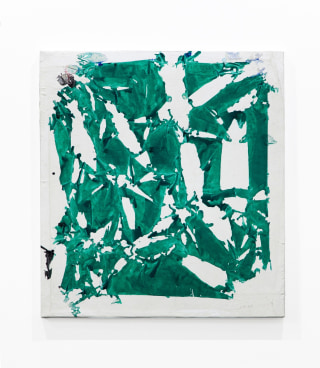In this exhibition, superbly curated by Molly Warnock, the paintings of Simon Hantaï are presented in New York, a city that has been very slow to appreciate and acknowledge the importance of this Hungarian French artist. Several times at the opening of the exhibition I heard the same comment—although images had been seen, one way or another, online or in a catalogue, this was in fact the first viewing of the actual paintings. And, as so often happens between Europe and the US, much can get lost in translation.
Jackson Pollock’s dripped paintings of the late 1940s and early 1950s exerted a challenge and presented an opportunity for painting; for Hantaï this meant finding technical alternatives to Pollock’s innovation in order to reinvent, and therefore reject essentialism, within the tradition of painting. All but one painting here, and the earliest, Sans titre (Untitled) (1958) are produced with Hantaï’s méthode(method) of pliage (folding), what might in the US be referred to inexactly as his process. Sans titre is made using a piece of metal, part of a defunct alarm clock, to scrape through in a gestural motion, the layer of still wet paint to the primed linen below. The reserve of canvas left unpainted in the later pliage paintings—the canvas bunched and tied before painting, then, after painting, unfolded and stretched, revealing a pattern of painted and unpainted canvas—relates to the negative line of gesture in Sans titre. However, an important change has occurred, specifically the exchange of speed (an investment in a form of automatism adopted from Surrealist methodology) to blindness, the slow painting of folded canvas that the artist is unable—is blind—to seeing, until the canvas is later unfolded and stretched. Both approaches reject a reliance on—or channeling of—subjectivity and amount to an exiting of self. Hantaï was particularly influenced by Georges Bataille’s writings on inner experience from the early 1940s. As Warnock said, in an elaboration of a point by Hantaï, “The procedurally blind labor upon the canvas is promised from the first to the work’s future unfolding, its revelation as a separate entity over and beyond its maker.” This position is quite a contrast to much contemporary painting I see that exalts identity and a conscious expression of self.

